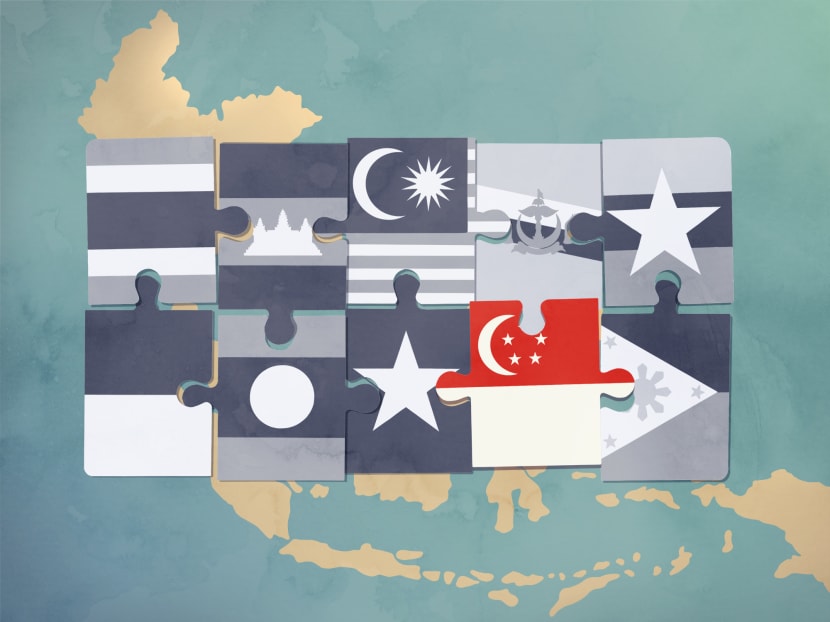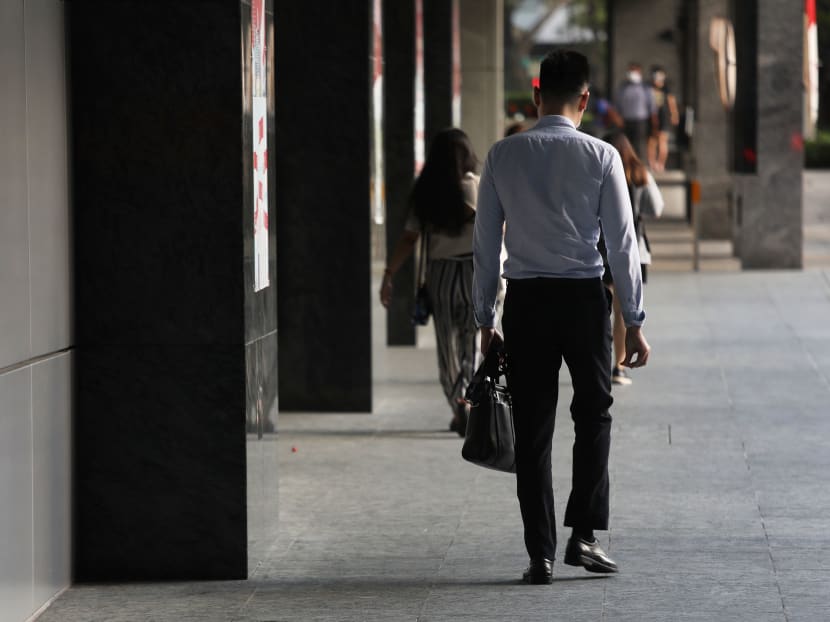The Big Read: With globalisation in retreat, Asean can offer S'pore a way forward in post-Covid world
SINGAPORE — As the head of a global manufacturing firm headquartered in the Republic, Mr Alessandro Perrotta has sent his Singaporean staff to be based in various countries — including Vietnam, Malaysia and Indonesia — where his company has operations.

In a global environment where countries are increasingly pressured to take sides amid heightened rivalry between the United States and China, the Asean region offers a suitable location for companies looking to diversify given the grouping’s more neutral political position, said one economist.
- Covid-19 has brought permanent changes to the global economy, affecting supply chains and work arrangements
- US-China tensions and rising protectionism could threaten Singapore’s trading hub status
- Economists and business leaders say Asean can capitalise on foreign multinationals divesting from China
- Whether Singapore will benefit from current economic trends still remains uncertain
- But the pandemic undeniably presents opportunities for accelerating Asean integration and growing new local industries, they said
SINGAPORE — As the head of a global manufacturing firm headquartered in the Republic, Mr Alessandro Perrotta has sent his Singaporean staff to be based in various countries — including Vietnam, Malaysia and Indonesia — where his company has operations.
Contrary to popular perceptions, he has never faced resistance from Singaporeans when they have to go to these countries stereotypically viewed as less liveable than the rich city-state, said the chief executive officer of Interplex Holdings.
“Singaporeans are some of the most flexible people I know… My team is willing to go anywhere, anytime.”
As companies here and elsewhere adjust to a new business normal brought upon by the Covid-19 pandemic, Mr Perrotta will continue to focus on the region due to its attractive opportunities.
It is an endeavour that Singapore itself has been actively pursuing over the last few decades: Greater regional integration with its neighbours in the Association of Southeast Asian Nations (Asean).
While negotiations for a more integrated Asean have been taking place in fits and starts over the years, experts and business leaders say the pandemic has presented governments and companies in the region with a great opportunity to intensify the push for further integration.
This is because Covid-19 has brought about permanent changes to the global economy as borders are shut, traditional supply chains disrupted and long-established working patterns upended.
World leaders and corporate honchos are now calling for companies to diversify their markets, supply chains and products, in the face of the endless difficulties wrought by the coronavirus outbreak, which has infected over 14 million people globally and killed nearly 785,000 thus far.
In a global environment where countries are increasingly pressured to take sides amid heightened rivalry between the United States and China, the Asean region offers a suitable location for companies looking to diversify given the grouping’s more neutral political position, said DBS Bank senior economist Irvin Seah.
Experts and business leaders stressed that with open borders and markets remaining crucial as ever to Singapore's development, its trade-reliant economy needs to continue building external linkages within Asean — amid the growing backlash against globalisation around the world that could threaten Singapore’s long-term survivability.
And the region still holds much promise, with a recent report from property consultancy Cushman and Wakefield noting that Asean manufacturing markets have a high ability to bounce back from the current economic slump due to the region’s demographics and economic capabilities.
Mr Douglas Foo, president of the Singapore Manufacturing Federation (SMF), said manufacturing companies are finding the option of using Asean as a manufacturing hub with Singapore as its base an even more attractive proposition amid the pandemic, as businesses are forced to be more resilient and agile.
The fact that “business as usual” is not possible even after the Covid-19 beast has been tamed — making it necessary for Singapore to build a new economy — was highlighted by Trade and Industry Minister Chan Chun Sing last week.
He said that the pandemic has caused irrevocable changes in four areas: The geopolitical environment which has seen rising tensions among major powers; the way global companies are reorganising their production and supply chains; the changing nature of jobs due to remote working; and the social tensions that could arise from the slowdown in global growth.
“The painful truth is this: We are not returning to a pre-Covid-19 world,” Mr Chan said on Aug 11, the day when his ministry announced Singapore’s worst economic performance on record.
It entered its deepest recession in 55 years as gross domestic product (GDP) for the second quarter of 2020 fell 13.2 per cent compared to the same period a year ago.
“This is not the Asian financial crisis or global financial crisis where if we hunker down, things will improve in a few months. If we wait it out, we will likely be in worse shape than we are now. Therefore we must chart a new direction now for a very different and uncertain future,” said Mr Chan.

US-CHINA TENSIONS
Global commerce, which has long been the lifeblood for Singapore, has stagnated.
Between 1985 and 2008, international trade had grown at nearly twice the rate of the world’s GDP, data from the World Bank showed. Since the turn of the last decade, the rate of growth has barely kept up.
The onset of the US-China trade war in 2018, along with rising protectionism in several countries, has dealt a heavy blow to an already slowing international trade.
Then came the unprecedented coronavirus pandemic early this year, which saw international trade almost grinding to a halt for weeks in the wake of lockdowns and port quarantines as governments scrambled to stop its rapid spread.
“It's like putting oil onto an existing fire,” said prominent businessman Ho Kwon Ping, who founded international resorts company Banyan Tree Holdings.
With shipments delayed because of Covid-19, the world realised how densely concentrated supply chains are in China, especially for the automotives, consumer electronics and pharmaceuticals sectors, said Mr Alex Capri, visiting senior fellow at the National University of Singapore Business School.
"We will see not only companies looking to diversify their supply chains, but also governments, either pressuring or actually passing legislation that will require companies to relocate some of those strategic supply chains”, such as those dealing with technology, he added.
Covid-19 could also be the impetus for multinational corporations (MNCs) to implement the “China plus one” strategy which business leaders have advocated for years as a way of diversifying the risk that comes with placing all their investments in China, Mr Capri said.
Mr Ho believes Asean is well-positioned to be that “plus one”.
“Where (MNCs) might have huge multibillion-dollar facilities all in China — with a head office in Shanghai — they may (now) want to put (the) head office in Singapore and factories in Thailand and Malaysia,” he said.
Mr Capri suggested that Singapore could also serve as an alternative location for the large semiconductor industry in Taiwan, with the island long been seen as a potential flashpoint between the US and China.
Singapore and other Asean member countries have for decades maintained a balancing act between the two major powers, consciously seeking to avoid being viewed as picking sides.
As geopolitical tensions intensify, Mr Capri noted: “Singapore’s challenge is going to be tiptoeing between both superpowers.”
The need for diversification is also on the cards for some trading companies TODAY spoke to. Several have shared how they have experienced shipment delays for both imports and exports because of the supply chain disruptions caused by the pandemic.
Mr Jeremy Fong, chief executive director of medical equipment manufacturer Fong’s Engineering, said that his clients mainly come from the US, which is experiencing one of the worst coronavirus outbreaks in the world.
Apart from changing the production schedule to allow for more lead time and increasing the inventory, he is now in negotiations with Japanese companies in a bid to diversify his customer base.
“They (the Japanese) have moved out their operations from China and are looking to set up in Southeast Asia. We see it as an opportunity,” said Mr Fong.
Mr Perrotta, whose company already has operations in 14 countries including Singapore, said he is getting new customers who are looking for suppliers closer to their consumption markets.
“Customers are coming to us and giving us opportunities, saying that their original supplier can’t serve them in the new location where they need to go.
“There is a change from where focus was on supply chain efficiency, (optimising) lead time from point A to point B at lowest possible cost, to now focusing on more supply chain resiliency… Everybody is now looking at other areas to get closer to production points. So Asean is definitely benefiting,” Mr Perrotta added.

S’PORE’S MNC STRATEGY: THREATS AND OPPORTUNITIES
While Singapore can benefit from the global corporations’ need to diversify, it will also have to grapple with another possibility: MNCs may not see the need to physically locate themselves in the Asean region anymore with remote working becoming more prevalent, and amid rising protectionism.
With governments providing incentives for their own corporations to move back amid growing protectionist sentiments, Mr Inderjit Singh, the founder of consumer electronics firm Solstar International, believes that MNCs will pull out of Singapore “in a very big way”.
For example, the Japanese government has earmarked 220 billion yen (S$2.84 billion) to help its companies shift their production out of China and back to Japan.
Associate Professor Walter Theseira from the Singapore University of Social Sciences said that cities such as Singapore have been well-positioned to take advantage of globalisation but these benefits are now cut because of the border closures.
With Singapore having established itself as the New York City or London of Asean, it used to be common to have professionals working in Bangkok or Jakarta during the week and returning to Singapore for the weekend.
“All of that has been put to an end by Covid-19 at least in the short-term… Does it mean that firms would say ‘I am going to just have minimal staff in countries I am doing business in and run more operations out of my regional headquarters or main markets I’m in’? There is no need for an in-between,” said Assoc Prof Theseira.
“It’s a very small step to go from a regional HQ in Singapore to just having work done back in the main HQ,” he added.
However, observers pointed out the movement of companies and jobs out of Singapore is not a new development but very much part of the globalisation process.
For example, Singapore lost its competitive advantage in manufacturing low-cost consumer goods such as textiles decades ago when labour costs went up, leading to many of these companies relocating their production to other parts of the region.
The subcontracting of certain business functions in a company to third-party vendors in other countries is also a manifestation of globalisation.
“It’s been happening for decades. It’s called business process outsourcing. Now, Covid-19 accelerated the idea or notion of working remotely. In the past, it was something deemed to be a strategy to bring down operating costs. But now, to some extent because of the pandemic, it becomes essential,” said Mr Seah.
The difference this time is that jobs taken up by professionals, managers, executives and technicians (PMETs) are being impacted.
Some observers said it is still too early to tell whether global corporations would change their behaviour and make the exit from Singapore.
While there may be a fraction of companies which choose to permanently work from their home countries, Maybank Kim Eng economist Chua Hak Bin said a countering force to that would be the need for diversification.
Mr Ho reiterated that “everybody is basically reexamining their approach, their strategies”. “And it's certainly not clear that Singapore is going to lose out completely, nor will Singapore be the total beneficiary,” he said.
Mr Seah, however, thinks the Republic’s importance — as a stable and reliable destination for critical business functions and processes — has actually been elevated because of the pandemic.
“Especially now travel becomes more difficult, you want to be close to where production bases are… At least overcome time zone difference (by locating) in a similar time zone,” he said.
Referring to the need for diversification, Mr Seah said it also makes sense for companies to have a regional headquarters that can take over the functions of the main office in the event another crisis severely impacts the latter’s operations.
To minimise the possibility of global corporations leaving the island, Singapore could adopt several measures, such as gradually reinstating international travel, maintaining a competitive tax regime and remaining open to global talent, experts said.
RISE OF REMOTE WORKING: DO S’POREANS STILL HAVE AN EDGE OVER ASEAN COUNTERPARTS?
As part of its profound irrevocable impact, Covid-19 has pushed remote working, which has been around for some time, to the fore of a radically changed economic landscape.
Despite its many positives, cost savings for businesses being one, such a work arrangement can be a double-edged sword, which may affect Singapore’s ability to attract new investments within Asean.
On the one hand, it provides opportunities for Singaporeans to work for companies which do not have operations here, without having to physically move to the firms’ locations.
On the other hand, with companies now able to cast the net much further beyond the confines of national borders in their search for talent, employers will have a much wider pool to choose from.
As Mr Chan noted at his Aug 11 press conference, “some jobs in the regional headquarters here are being advertised as ‘can work in Singapore’ or ‘can work remotely’”.
“This will affect many PMET jobs, which can be done virtually or through automation and AI,” he said.
Assoc Prof Theseira suggested that remote working could lead to a divergence among PMET jobs where companies are looking for either “cheap and good” workers or “high-value and bespoke” professionals.
For example, many software engineers from Vietnam could fall into the category of “cheap and good” as they meet the minimal requirements of what a company needs and come at a low cost. On the other hand, product designers for a tech company such as Apple could qualify as “high-value and bespoke” work.
Given that Singapore can never compete with “cheap and good” talent, the question is then whether there are enough Singaporeans who could offer “bespoke” quality, said Assoc Prof Theseira.
In the Asean context, while Singaporean workers are generally more well-educated and skilled, there is however no lack of talent in other member countries due to their much larger labour pool, especially in the area of technology, he noted.
“We should be quite careful about our assumptions about the region. We cannot just assume that everybody is uneducated or 30 years behind us. That’s completely not true,” said Assoc Prof Theseira.
There is thus a need for Singaporeans to find a comparative advantage, which could be skills such as proficiency in the English language or familiarity with Western markets, he noted.
Mr Seah, however, cautioned against over-estimating the prevalence of remote working as there are obvious limitations to the arrangement.
Cultural differences, language barriers, different employment regulations between Asean countries as well as different management styles of companies could hinder the extent companies can rely on remote work.
Remote working may be feasible for short-term projects, but it would not be possible for a management executive who has to deal with the daily operations, noted Mr Seah.
While Singaporeans should have an international dimension when making career decisions given that remote working may be the norm in the future, Mr Seah cautioned that there is still a long adjustment process to reach that stage.
If policymakers start urging Singaporeans to look for remote working opportunities all over the globe, they “run the risk of neglecting some Singaporeans who cannot cope with the change,” he said.
WHAT S’PORE, ASEAN NEED TO DO
The push for greater integration of Asean is not new for Singapore, a city-state without a hinterland.
SMF’s Mr Foo said a lot of groundwork had been laid over the past few years through the inking of various agreements with similar trade groups in Malaysia, Thailand, Vietnam and Myanmar.
Concerns on whether companies are able to find the right partners or understand the markets have been progressively addressed through these efforts, he said.
Covid-19, however, has renewed interest in the grouping as an economic community among Asean-watchers. They say that its 10 members should capitalise on the “new normal” to win foreign investments and accelerate the long-term goal of creating a single Asean market, akin to the European Union’s.
Singapore has always positioned itself as a regional hub, but Mr Seah felt that it has not participated in the economic development and helped to drive growth in the region as much as it has invested in China.
But with Asean potentially a hotbed for foreign direct investments in a post-Covid-19 world, he said that Singapore has to double its efforts in investing more actively in the region.
“If the region benefits from global foreign direct investment, we will benefit from growth in the region,” he added.
In Asean, there are incentives in place to attract businesses to the region, such as the free trade agreements among the member countries and with other Asian nations such as China.
But Mr Ho believes there are other areas where more can be done to smoothen business operations in the region if Asean really wants to seize the opportunities created by the pandemic.
He said Asean can take the cue from the Asia-Pacific Economic Cooperation, which issues a business travel card that allows business travellers from member economies access to other APEC regions without a visa.
“Imagine... if you don't even need a passport, you just have a card that you can scan to go to any Asean country, this will be meeting the nitty-gritty issues of integration, as far as business people are concerned,” Mr Ho said. “It’s a pain if you’re a frequent traveller to your different factories.”
Ease of travel between member countries could also offset some of the pain from border closures and boost regional tourism, Assoc Prof Theseira noted.
While Asean is poised to offer Singapore new opportunities as it seeks to adapt its economy to a post-pandemic world, experts and business leaders stressed that the Republic must continue to remain an open trading hub even as other countries are turning inwards.
“There are certain things that we have been doing that we know we have to continue doing,” said Mr Ho. “The fact that we have no natural resources and only management skills to sell, that won’t change.”
He believes the key for Singapore to remain relevant is to be more agile in identifying nascent opportunities, not in entire sectors, but in certain niches of each industry.
Solstar International’s Mr Singh sees that niche in Singapore becoming the prototyping factory of the world, bringing research from lab to factory.
“Singapore research institutes and universities do excellent research and have great technologies, and what we lack is commercialising these,” said the former Member of Parliament.
“I have seen a few good technologies that could have started initial prototyping and initial production in Singapore, had they found the money to do so,” he added. “Instead, they went straight to other countries.”
In order to build up Singapore’s capabilities in advanced manufacturing and prototyping new technologies, Mr Singh suggested that the Government support local enterprises and tap sovereign wealth funds to buy over distressed global companies and bring them to Singapore.
He added that the old assumptions about Singapore’s expensive land and labour costs should not stop the country from rebooting its manufacturing sector. Industrial land costs can be brought down by the Government while the highly trained workforce can be tapped to automate factories to lower the reliance on labour.
PMETs who have been displaced can also take up key positions or be trained and redeployed to work in these manufacturing and technology firms.
Mr Kurt Wee, the president of the Association of Small and Medium Enterprises, said that businesses looking to expand into Asean should not just identify which market they want to serve, but also identify the marketplace platform dominant in a particular country.
For example, while e-commerce firm Lazada is commonly used by consumers in Singapore, Tokopedia is the go-to for Indonesians.
Mr Foo said that Singaporeans need to have an open mind about the potential of Asean and ditch the negative stereotypes long held about their neighbours.
He pointed out that having grown up in the multicultural city-state, Singaporeans should have no problems embracing diversity, and they should see other Asean countries, their people and cultures as something worth discovering.
“Take it as a new journey of discovery of our neighbourhood,” he said.
Still, it remains to be seen whether Covid-19 will give Singapore’s neighbours the impetus to move faster towards even greater economic integration.
While the virus has necessitated closer cooperation among Asean countries in terms of the supply of medical equipment and the exchange of critical information to fight the pandemic, it has also created much pain in the respective countries’ domestic sectors, noted Mr Seah.
“There could be more impediment and resistance to opening up their domestic economy,” he said.
Dr Chua said that signs are emerging that Asean governments are turning more nationalistic, due to the host of domestic issues which they need to address because of Covid-19.
“Every country is in a job crisis. They have to take care of their own people first. In some cases, they may erect higher protective barriers to protect their own people,” he said.













